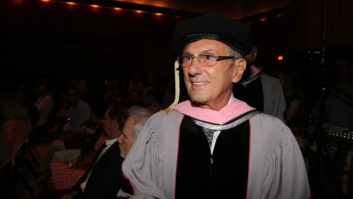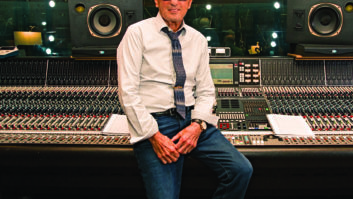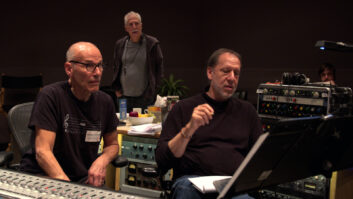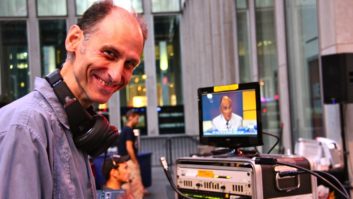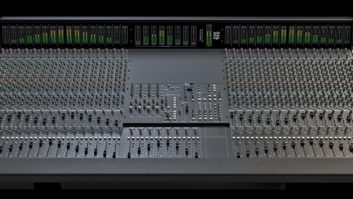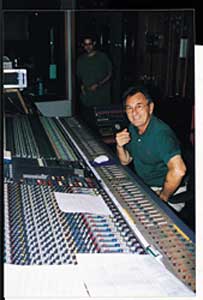
Al Schmitt’s had quite a career so far: He’s been awarded seven Grammys for Best Engineered Album—the first, for Henry Mancini’s Hatari in 1962 and the most recent in 1996 for Quincy Jones’ Q’s Jook Joint. He’s also collected that coveted award for George Benson’s Breezin’, Toto IV, Steely Dan’s Aja and FM, and for Natalie Cole’s Unforgettable. In addition to accumulating all those statues, he’s been nominated for the award 11 more times, and he’s recorded and/or mixed more than 150 Gold and Platinum Albums.
Those achievements are mirrored in the respect Schmitt is accorded by his peers. Descriptions of him by people he’s worked with tend to go like this: “Naturally musical with amazing ears;” “Intuitive, and he gets the big picture”; “Always goes the extra mile;” “The consummate live engineer, nobody can touch him;” and finally, “Al is a class act—just simply the best.”
The owner of those amazing ears got his first job at age 19 at Apex Studios in New York City, where he worked with his mentor, Tom Dowd. He went on do to work for Atlantic and Prestige Records, then moved to California to work at Radio Recorders. When RCA opened its own studio at Sunset and Vine, Schmitt was the first engineer hired; he worked for that label as both a staff engineer and producer with artists including Jefferson Airplane, Sam Cooke, and Eddie Fisher and the Limelighters, before going independent in 1966.
These days you’ll find Schmitt working on projects as diverse as ever—when I spoke with him, he was mixing at The Village with country artist Michael W. Smith, and he’d just finished mixing a Lou Rawls album, recording Paul Anka dueting with some original Sinatra tracks, and recording orchestras for Bette Midler and new artist Niles Rivers. His upcoming sessions include the stereo and 5.1 surround mixes at Capitol for Vince Gill’s Christmas album, an orchestra date with producer David Foster for a Van Cliburn theme for Las Vegas’ Bellagio Hotel, album mixing for Monica Mancini, and recording and mixing for the Benny Carter Big Band. You’d think at this stage in his career Schmitt could take weekends off! Instead, on the Saturday we met he took a long lunch break and settled in for some questions.
Can you describe your style of engineering?
I think a big part of it is the way I started and learned; I’ve been in the recording studio since I was seven—that’s the truth. My uncle had a studio, so as a kid on weekends I’d go over and hang out. Seven years old on the subway by myself, from Brooklyn to Manhattan, and I’d spend the weekend watching them recording; they did everything with one microphone.
Then, when I finally started to work in the business, the studio I started at had a 6-input console—we could put up six microphones. I worked with Tommy Dowd and I learned how to mike—how to get the most out of an instrument and how to place people in the room to capture the best sound with as few microphones as possible. So basically, what I do is acoustic; it’s microphone technique. I rarely, rarely use EQ—if you go in and look at the board, you’ll see. I may use EQ if I’m mixing something someone else recorded, but, if it’s something I’ve done, I hardly use it at all. And I don’t use much limiting or compression. If I do use a compressor or limiter, I’ll use a tube one and I’ll pull maybe a dB—I’ll use it mostly to get the sound of the tube.
Also, I learned to do everything at one time. When I was doing all those Mancini dates and those Ray Charles dates, it was all done in mono and 2-track, so what you got on tape was it. You had to make sure you got a good balance, and the right perspective in bass, drums, guitar, strings, vocal, echo…it all had to be done at the same time. Fix it in the mix was unheard of—there was no mix.
Explain a bit more about how you place a mic.
After years and years of experience, I know most microphones, and if something doesn’t sound right to me, I’ll move the mic a bit and see what that does, or I’ll change the microphone. I’ll change a Neumann 67 for another Neumann 67—because they don’t all sound the same.
Certainly, if you’ve got a mic on the kick drum just moving the mic an inch can make a difference. The same with acoustic guitar or pianos. I used to watch guys have a mic up and they’d want something to be brighter and so they’d add 8 dB of EQ to it. That would be so strange to me. Instead, I’ll change the microphone to enhance the sound. To me, unless you’re trying for an effect, adding 8 dB of anything is really radical.
I hear you kept a notebook when you were starting out.
I had one of those notebooks like kids take to grade school, and when I watched dates I’d draw a sketch—a diagram of where they had the microphones—note what microphones, and so forth. That really helped me early in my career. When I would have to do something, I’d get my notebook out. When I first had to do a large orchestra with woodwinds and strings, I was nervous and I went to a guy named Bob Dougherty, who helped me out—I watched a bunch of his dates and drew sketches. I was worried about recording French horns and so forth, but he told me not to worry, that it was easy. And it was easy. I finally learned, after many times of doing it, that the more people you have in the studio the easier it is to record. Recording 65 pieces is a snap—it’s much more difficult to record an eight-piece! I did something recently with David Foster for Quest for Camelot where we had a 95-piece orchestra. There’s nothing that sounds like 95 pieces going off—you open up those microphones with eight basses and 12 celli, and 32 violins…It’s just magnificent, and really, it’s basically all captured with the overhead microphones. You know, I don’t have any secrets. Anyone who wants to know what I do—I’m glad to tell them exactly how I do it, then they go on and perfect it to their own taste.
Is it true that your first real session was with Duke Ellington and that you didn’t know about it in advance?
I had no idea, and I probably would’ve stayed home if I’d known. I was three months at Apex Studios and I had graduated to the point where I could do what they called demo records, little voice and piano things where somebody had written a song, and they’d come in and play it on piano and sing, and we’d give them a disc and they left.
It was a Saturday, and I had three things to do. The first one, as I recall, was a cantor—the guy came in and just canted, and I got it on record and gave it to him. The next one was voice and piano—happy birthday to Joe or Sam or whatever. And my last thing, called Mercer, was scheduled for 2 o’clock in the afternoon and looked like it was booked for half an hour. So I’m waiting for Mr. or Mrs. Mercer, and the next thing I know, the elevators open up and these guys are getting out with trumpets and trombones and saxophones saying, “We’re here for the record date.” So I said, “Wait a minute, there’s a mistake! There’s no record date here,” and they’re saying “Oh yeah, Mercer Records, 2 o’clock.”
I tried to call my boss, I tried to call Tom Dowd, and couldn’t reach anybody. We didn’t have a maintenance guy; it was just me by myself, and I had to do it. So I got my notebook out and saw what the big band setup was, and we set up everything—Duke Ellington couldn’t play piano, because it was actually for Mercer Records, his son’s label, but they were using the Ellington band, and he sat right next to me. I kept saying “I’ve never done this before, this is a mistake and I’m not qualified!” And he kept patting me and saying, “We’ll get through this.”
So you, all alone, set up microphones, used the console, ran the lathe…
Made sure the exhaust was going on and cut the shellac, as they used to call it.
And wore a tie and a jacket.
Definitely. It was great when it was over. I felt really good that I did it, but if I’d known the night before, I honestly don’t know if I would’ve come to work. I felt so frightened.
It’s what you dream about, and it’s what you’re in the business for, but the fear…I remember the first big orchestra date I did—about 60 pieces—I was so nervous that when I walked up to the console I kept my hands in my pockets because they were shaking so much. And when I sat down I took my hands out of my pockets and grabbed onto the big rotary faders, just so people wouldn’t see my hands shake.
Isn’t it true that the way you work you’re really mixing right from the beginning—changing levels while you’re recording if need be?
When I start a date, I’m planning ahead, and as I’m doing the date I’m not only recording and getting it on tape, I’m also getting it ready to mix to 2-track, so I have an idea of how I’m going to place things. I also try to use similar echoes to what I’ll use in mixdown. I think that’s something young engineers should get into—to think ahead, not just to think, “Let me get this right now and I’ll worry about that later.”
What are those echoes and reverbs you like to use?
Well, of course I learned on live chambers, and I still like live chambers. That’s one of the reasons I love Capitol Studios; they also have one at Village that’s great.
When I was a staff engineer at RCA, I used to use five large chambers, one each for center, left and right, one for left-center and one for right-center. That’s how the returns came back—so if I was putting something in the chamber on the left, it came back on the left also. That’s where the echo stayed. It wasn’t like using it in stereo; it gave you a lot more transparency. And I always made sure the chambers were working well. I used quality microphones in them—tube 47s—and the walls were shellacked to have a glassy surface. So I still use live chambers when I can; I also like to use plates. I love the old EMT 250; I have the TC Electronic M5000—there are some great chambers in there that I use—and I also like the Lexicon 480. I use a lot of different, discrete echo: one just for the strings and one for the vocals and another for drums. I never have a lot of things going into the same chamber.
Are you still mainly recording to analog?
Yes. I prefer it. I did just use digital on the Vince Gill record. We used the new Studer, and I was surprised. It sounded really good. I also hear the 24-bit Sony sounds great. But before that project, I was never really thrilled with digital sound. Analog always sounds much better to me. Even in situations where I’m doing a large orchestra—say Johnny Mandel or something, and he’ll want to use a lot of tracks—we’ll lock up two 24-track analogs and record that way. It’s a little slow, but I prefer it to 48-track digital.
You mix to half-inch.
Usually to half-inch BASF 900 +5 or 6, and on some occasions I’ll use Dolby SR.
You’ve worked with some of the greatest singers. How do you make them feel comfortable?
First of all, when you’ve been around as long as I have, they know what you’ve done, and they have confidence.
Well, conversely, I would think sometimes they’d almost be afraid of you!
That has happened with a couple of singers. With one artist, she was so nervous because I was there, I seriously thought about having the assistant do it and walking out of the room so she wouldn’t be so intimidated. That’s a tough thing to say, but it’s true, and so funny for someone who sings as well as she does.
But singers are often like that—very sensitive.
Exactly. So you just make friends. It’s almost like you’re stroking them into a sense of, “Look, we’re going to get this done, and I want you to be as comfortable as you can. We’re gonna put the microphone here. If it’s uncomfortable here, we’ll move it a little bit. We’re gonna make sure you hear well. If there’s anything you’d like in the ’phones, let us know.” You try to make them feel like it’s their environment, and it usually works.
How do you choose mics for the singer? Do you put up several?
Sometimes. I usually have two or three that I particularly like, and if I know the singer and the type of voice I pretty much know what microphone I want to use. Again, if the kind of song they’re singing changes—sometimes with one artist on ten or 12 songs, we’ll use two or three different mics. But generally, I’ll use either a 251, a 67, a tube 47 or an M149.
Usually, I’ll start with one, and I’ll have another warming up right there so if I’m not thrilled I’ll quickly change it. You don’t want the artist to think that you’re experimenting, so it’s nice when you’re confident about what you are doing. I also have certain preamps that I like: I use the Martech a lot lately, and I use Doug Sax’s Mastering Lab preamps. I love those. So on vocals, it’s either one of those. My chain is usually the good microphone into one of those preamps, into the Summit limiter for maybe a dB. I use mostly hand limiting. I ride gain on the vocals, but I use the Summit for the sound.
Do you set up the headphone mixes?
Not as much as I used to. I work with certain guys all the time like Bill Smith and Charlie Paakkari who are so good at that, they really have it down, and I don’t get involved so much any more. They’re tweaking all the time we’re recording, making sure that everything is set. Really, they’re mixing the earphones. That’s why I like to work with certain people at certain studios—my assistants are always completely involved. It used to be you turned around and you’d see the guy running the tape machine reading a magazine. That never happens on my dates. Everybody is involved, and everybody gets respect for what they do. I think that’s important, and I think the guys then give even more.
Do you own any equipment?
I own a lot, microphones mostly, and preamps: a Martech preamp, the Studer valve preamp—we use that as an A-to-D converter also—Summit limiters. I also own Mastering Lab speakers.
I was just going to ask what speakers you use.
I listen on Mastering Lab speakers, the ones that Doug Sax put together. I bring them around with me. I have two sets, but I need to get one more for doing surround.
Since you use so little EQ, how do you get instruments, especially drums, bright enough?
Again, for me it’s where you put the microphones and how they sound. You don’t want to be adding a lot of high end to violins or even drums—you can do it with microphones. On the snare I use a 451 or 452 on top, and under I have a 57 that’s out of phase so if I need more crispness, more of the snare sound, I can bring the bottom up and get it that way. I use a 451 on the hi-hat, 414s on the toms, and I use bright mics on the overheads—149s or C12s—something that gets a nice cymbal sound. I may add a little air around 20,000. If it’s in a big enough studio, I’ll use M50s in the room, and that’s usually the drum sound. It’s really where you put things, how you mix them and how you use the echoes that makes them sound right.
What mic might you use on bass drum?
An AKG D-112 mostly. Sometimes I’ll use two, a D-112 up close and tight and maybe a FET 47 farther away.
The other thing that’s very important to the sound is where you place the musicians in the room. The more comfortable they are, the closer together they are, the tighter they are, the better things sound and the better they play. If you can work it out so that the musicians can play without ’phones, that’s ideal. If they can run something down and not have to worry about having the ’phones on, they hear better and the level they play at is comfortable.
Years ago when we were worried about leakage, guys would try spreading the musicians out, moving them farther and farther away from each other. Well, the drummer would then play louder and louder! So I learned that moving people closer together made them play at a more comfortable level. It worked better for me and for them.
People are concerned that placing the musicians close together causes problems with leakage, but I learned that leakage is your friend back when we’d record everything at once direct to 2-track. A lot of times what you picked up from the drums was the leakage going into the bass microphone, acoustic pianos and so forth. On big band dates, you’d have a mic on the drums but a lot of the sound was from the drums leaking into other instruments’ mics—and it’s that leakage that actually will make things sound big. Which is why you should always use really good mics, because you are getting leakage into a really good microphone so the leakage sounds good, and that makes a big difference.
Some more mic questions, please. What do you usually use on a horn section?
Neumann 67s on trumpets, saxes and trombones, and for the trumpets I’ll put them in omnidirectional. You don’t have to worry about much leaking into them, because trumpets are the loudest thing in the room.
I do that a lot with strings, too: I use 67s and put them in omnidirectional; the mic sounds better, and you get the room also—that sound coming back off the ceiling or whatever.
People sometimes ask me, “If you only had one mic, what would it be?” And it would probably be a Neumann 67, or maybe lately the M149—I really love that mic. It’s gorgeous, with a lot of power and a lot of gain. But before that it was a 67. You can use it on vocals, strings, brass, piano; it works well on anything.
You’d use the 67 on baritone sax as well?
Yes. Again, where you place the mic is so important. The sound doesn’t come just from the bell. A lot of people make that mistake. The same with a clarinet—a lot of the sound is coming from around the keys. I always tell guys to go out in the room and listen. Listen to what the instrument sounds like, then go inside and try to duplicate it. That’s what your job is. You’re trying to capture that sound out there. I always try, if it’s an orchestra date, to be out in the room on the first rundown so I can hear what the arrangement’s about and what it sounds like, and then the next time they’re running it down I’m inside getting myself together.
How do you mic French horns?
I use M49s lately—they sound really good. Where you place the mic depends on the sound and the arrangement. In some cases I’ll put the mics behind the French horns, so I’m capturing sound right off the bell, and other times I’ll put the mics in front, with a reflector behind the horns so the sound will come off of it. Most studios have gobos that have a hard side, or I put them in a spot in the room where they’re going to reflect off a wall. So, it just depends.
But you have to decide before you start.
Not necessarily. I try to figure it out ahead of time, but sometimes I listen to the arrangement during the rundown and say, “Oops, lets get them out front.”
Okay, what’s that famous basic Al Schmitt string setup? Two mics in the front up high…
M149s or M50s when you can find them. I keep trying to talk Neumann into making the M50s again—no luck yet. But I just saw a new mic that they came up with, they only had one and it’s handmade, an M147 that will be out some time this year. It’s patterned after the old 47, and it’s going to be a really nice microphone.
67s on the strings…
Usually two mics on the string section, maybe one or two on the violas, and another couple on the celli, depending on the size of the orchestra.
For the basses I try to use tube 47s. There’s a lot of warmth to them, nice fat bottom. They always sound good, and the bass players appreciate it also; they like those mics.
Well, here’s the closer. What advice would you give young engineers who want to know how to have a career as long and successful as yours?
Enjoy every day—enjoy what you’re doing. And also, try to learn something new every day.
When I go home at night, I’ll think about that: “What did I learn today that I didn’t know?” I consciously do that, and usually there’s something, some little thing that I learned. You have to keep learning. There’s a lot of things that young engineers do that I hear and I’ll ask, “How did you do that, how did you get that sound?”
My son gets in the car with me with his tapes and plays rap music all the time, and once in a while I’ll hear something and think, “How the hell did they do this?” And I’ll get the tape from him and bring it into the studio with some assistants and try to figure out how they did it. And I may wind up using it myself or using something similar to it.
I also think it’s important to work on different kinds of music—I was really fortunate in my years at RCA that I got to do classical music, country, jazz and pop, and I still work on all different kinds of music.
So you’re still glad to be going to work in the morning?
Absolutely. Setting up an orchestra, putting up mics and seeing the same woodwind players and string players you see all the time, you get to know everybody, and they help you and you help them. It’s always nice when I see somebody who says to me, “I’m glad to see it’s you working—I know we’ll have a good day.” Things like that make me feel good.
Really, we are all blessed in this business. Because, in this business if you don’t like what you do, you don’t become good at it; most of the people you’re working with love what they do. Every day isn’t perfect, but overall, what’s not to love? It’s fun to hang around in the studio with musicians, we always make sure we eat well, [laughs] and we make good music.
